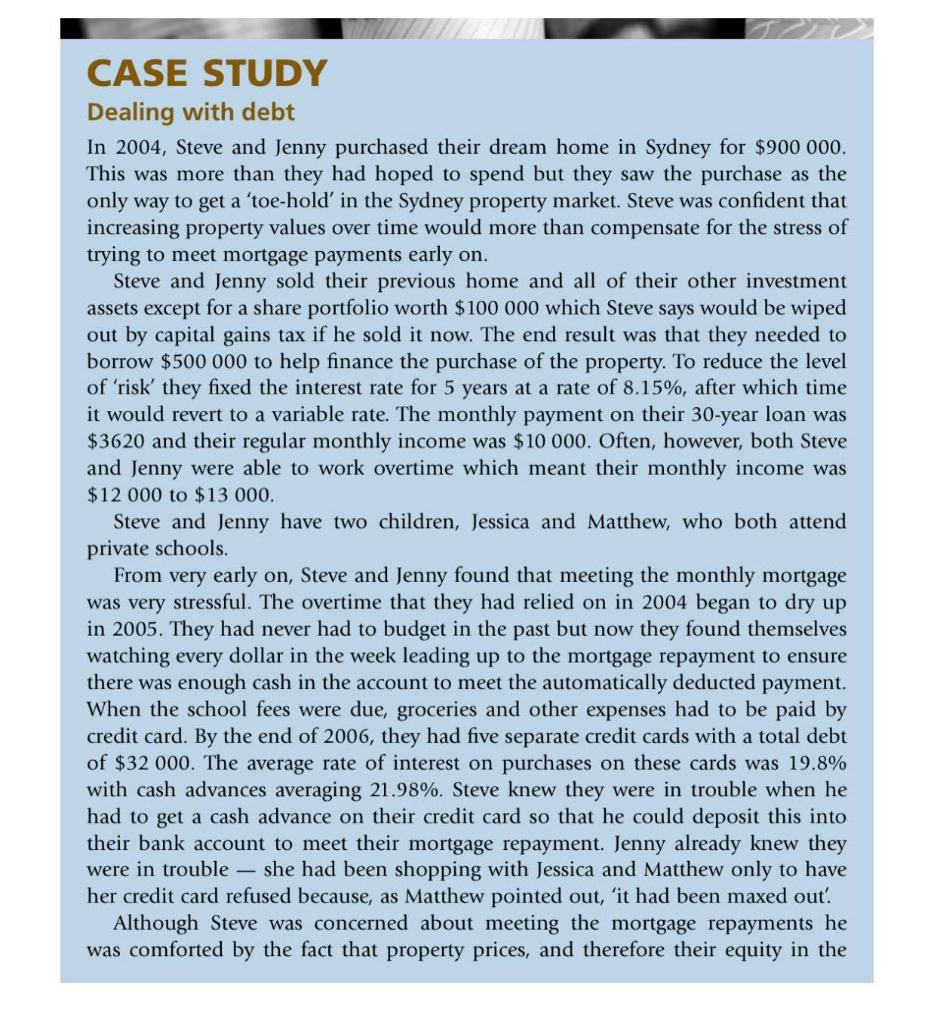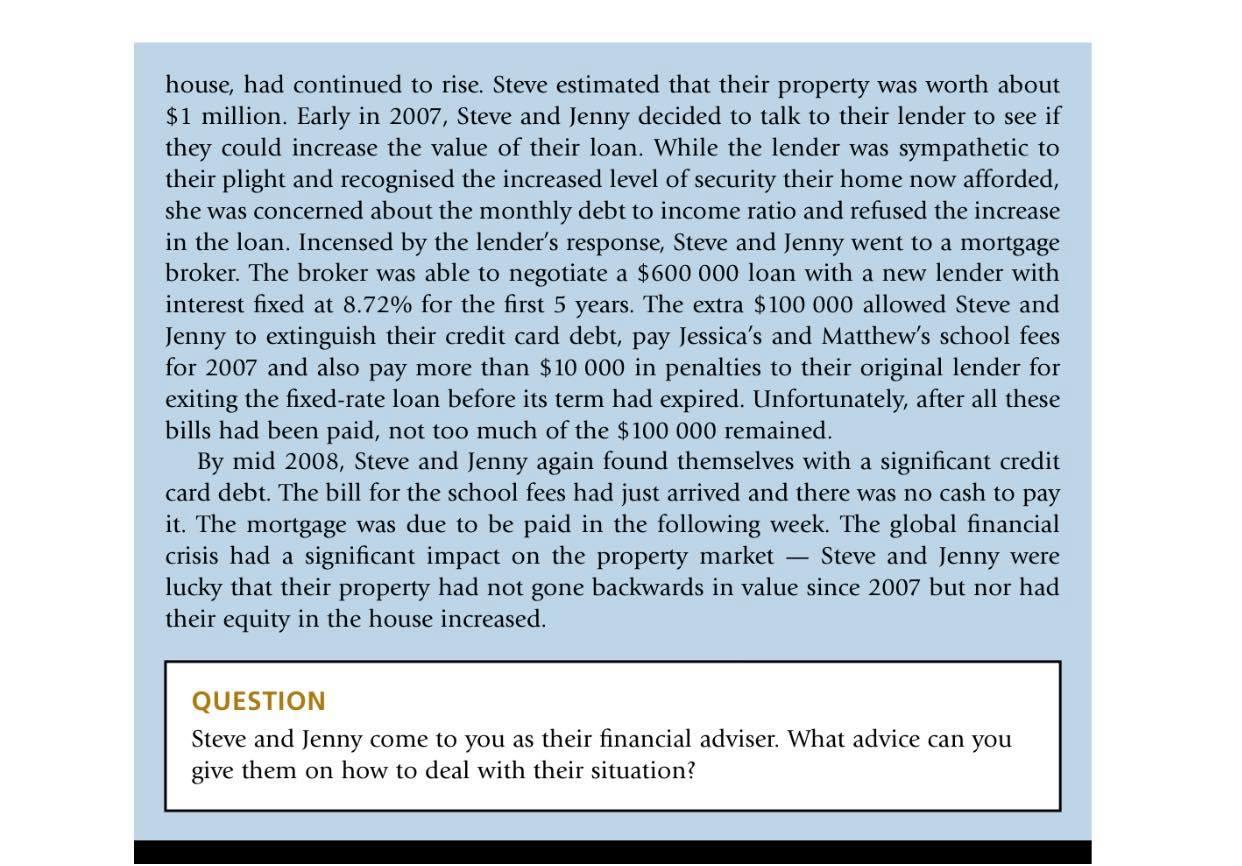Answered step by step
Verified Expert Solution
Question
1 Approved Answer
Please help me to answer this question on the text book. CASE STUDY Dealing with debt In 2004, Steve and Jenny purchased their dream home


Please help me to answer this question on the text book.
CASE STUDY Dealing with debt In 2004, Steve and Jenny purchased their dream home in Sydney for $900 000. This was more than they had hoped to spend but they saw the purchase as the only way to get a 'toe-hold' in the Sydney property market. Steve was confident that increasing property values over time would more than compensate for the stress of trying to meet mortgage payments early on. Steve and Jenny sold their previous home and all of their other investment assets except for a share portfolio worth $ 100 000 which Steve says would be wiped out by capital gains tax if he sold it now. The end result was that they needed to borrow $500 000 to help finance the purchase of the property. To reduce the level of 'risk' they fixed the interest rate for 5 years at a rate of 8.15%, after which time it would revert to a variable rate. The monthly payment on their 30-year loan was $3620 and their regular monthly income was $10 000. Often, however, both Steve and Jenny were able to work overtime which meant their monthly income was $12000 to $13 000. Steve and Jenny have two children, Jessica and Matthew, who both attend private schools. From very early on, Steve and Jenny found that meeting the monthly mortgage was very stressful. The overtime that they had relied on in 2004 began to dry up in 2005. They had never had to budget in the past but now they found themselves watching every dollar in the week leading up to the mortgage repayment to ensure there was enough cash in the account to meet the automatically deducted payment. When the school fees were due, groceries and other expenses had to be paid by credit card. By the end of 2006, they had five separate credit cards with a total debt of $32 000. The average rate of interest on purchases on these cards was 19.8% with cash advances averaging 21.98%. Steve knew they were in trouble when he had to get a cash advance on their credit card so that he could deposit this into their bank account to meet their mortgage repayment. Jenny already knew they were in trouble she had been shopping with Jessica and Matthew only to have her credit card refused because, as Matthew pointed out, 'it had been maxed out'. Although Steve was concerned about meeting the mortgage repayments he was comforted by the fact that property prices, and therefore their equity in the house, had continued to rise. Steve estimated that their property was worth about $1 million. Early in 2007, Steve and Jenny decided to talk to their lender to see if they could increase the value of their loan. While the lender was sympathetic to their plight and recognised the increased level of security their home now afforded, she was concerned about the monthly debt to income ratio and refused the increase in the loan. Incensed by the lender's response, Steve and Jenny went to a mortgage broker. The broker was able to negotiate a $600 000 loan with a new lender with interest fixed at 8.72% for the first 5 years. The extra $ 100 000 allowed Steve and Jenny to extinguish their credit card debt, pay Jessica's and Matthew's school fees for 2007 and also pay more than $10 000 in penalties to their original lender for exiting the fixed-rate loan before its term had expired. Unfortunately, after all these bills had been paid, not too much of the $ 100 000 remained. By mid 2008, Steve and Jenny again found themselves with a significant credit card debt. The bill for the school fees had just arrived and there was no cash to pay it. The mortgage was due to be paid in the following week. The global financial crisis had a significant impact on the property market Steve and Jenny were lucky that their property had not gone backwards in value since 2007 but nor had their equity in the house increased. QUESTION Steve and Jenny come to you as their financial adviser. What advice can you give them on how to deal with their situation? CASE STUDY Dealing with debt In 2004, Steve and Jenny purchased their dream home in Sydney for $900 000. This was more than they had hoped to spend but they saw the purchase as the only way to get a 'toe-hold' in the Sydney property market. Steve was confident that increasing property values over time would more than compensate for the stress of trying to meet mortgage payments early on. Steve and Jenny sold their previous home and all of their other investment assets except for a share portfolio worth $ 100 000 which Steve says would be wiped out by capital gains tax if he sold it now. The end result was that they needed to borrow $500 000 to help finance the purchase of the property. To reduce the level of 'risk' they fixed the interest rate for 5 years at a rate of 8.15%, after which time it would revert to a variable rate. The monthly payment on their 30-year loan was $3620 and their regular monthly income was $10 000. Often, however, both Steve and Jenny were able to work overtime which meant their monthly income was $12000 to $13 000. Steve and Jenny have two children, Jessica and Matthew, who both attend private schools. From very early on, Steve and Jenny found that meeting the monthly mortgage was very stressful. The overtime that they had relied on in 2004 began to dry up in 2005. They had never had to budget in the past but now they found themselves watching every dollar in the week leading up to the mortgage repayment to ensure there was enough cash in the account to meet the automatically deducted payment. When the school fees were due, groceries and other expenses had to be paid by credit card. By the end of 2006, they had five separate credit cards with a total debt of $32 000. The average rate of interest on purchases on these cards was 19.8% with cash advances averaging 21.98%. Steve knew they were in trouble when he had to get a cash advance on their credit card so that he could deposit this into their bank account to meet their mortgage repayment. Jenny already knew they were in trouble she had been shopping with Jessica and Matthew only to have her credit card refused because, as Matthew pointed out, 'it had been maxed out'. Although Steve was concerned about meeting the mortgage repayments he was comforted by the fact that property prices, and therefore their equity in the house, had continued to rise. Steve estimated that their property was worth about $1 million. Early in 2007, Steve and Jenny decided to talk to their lender to see if they could increase the value of their loan. While the lender was sympathetic to their plight and recognised the increased level of security their home now afforded, she was concerned about the monthly debt to income ratio and refused the increase in the loan. Incensed by the lender's response, Steve and Jenny went to a mortgage broker. The broker was able to negotiate a $600 000 loan with a new lender with interest fixed at 8.72% for the first 5 years. The extra $ 100 000 allowed Steve and Jenny to extinguish their credit card debt, pay Jessica's and Matthew's school fees for 2007 and also pay more than $10 000 in penalties to their original lender for exiting the fixed-rate loan before its term had expired. Unfortunately, after all these bills had been paid, not too much of the $ 100 000 remained. By mid 2008, Steve and Jenny again found themselves with a significant credit card debt. The bill for the school fees had just arrived and there was no cash to pay it. The mortgage was due to be paid in the following week. The global financial crisis had a significant impact on the property market Steve and Jenny were lucky that their property had not gone backwards in value since 2007 but nor had their equity in the house increased. QUESTION Steve and Jenny come to you as their financial adviser. What advice can you give them on how to deal with their situationStep by Step Solution
There are 3 Steps involved in it
Step: 1

Get Instant Access to Expert-Tailored Solutions
See step-by-step solutions with expert insights and AI powered tools for academic success
Step: 2

Step: 3

Ace Your Homework with AI
Get the answers you need in no time with our AI-driven, step-by-step assistance
Get Started


